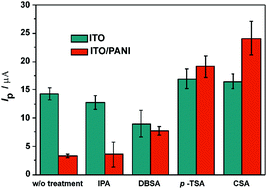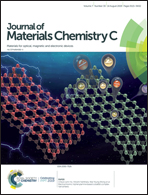An efficient post-doping strategy creating electrospun conductive nanofibers with multi-functionalities for biomedical applications†
Abstract
Highly conductive and uniform electrospun nanofibers bearing inherent desirable bioanalytical functionalities have been enabled through a facile fabrication strategy, namely post-doping. Here, spinning non-conductive polyaniline (PANI) blended with poly(methyl methacrylate) (PMMA) onto indium tin oxide (ITO) and simple 1 h soaking with acids reliably generated conductive PANI nanofibers (ITO/PANI). This alternative approach is not only very simple but also overcomes the otherwise dominant problems of poor electrospinability and low uniformity of nanofiber morphology caused from intrisic high ionic conductivity of the spinning solution. The post-doping process was carefully studied using inorganic and organic acids, aqueous and isopropyl alcohol solvents, and various incubation times to maximize the binding strength between acid dopant and the nanofibers as well as electrochemical performance. Cyclic voltammetry and contact angle measurements revealed that especially organic acids in isopropyl alcohol result in efficient doping of PANI nanofibers without corroding the ITO surface. Camphorsulfonic acid was optimal as it binds strongly to the PANI nanofibers and provides significant electrochemical signal enhancement in comparison to the more hydrophobic p-toluenesulfonic acid and dodecylbenzenesulfonic acid. Furthermore, subsequent thermal treatment at 140 °C enhanced the stability of the doped nanofibers while preserving the porosity and thermal properties of the fiber mat. Under optimized conditions, PANI/ITO electrodes not only significantly improved electrochemical performance over bare ITO and conventional pre-doped PANI/ITO with respect to electron transfer and signal intensity for dopamine sensing but also offered unique features that have never been realized in previous studies. Herein, the electrode was shown to be highly selective for dopamine even against a 100-fold higher concentration of the interferent ascorbic acid. Furthermore, the strategy enables the efficient fabrication of electrochemically active polydopamine nanofiber hybrids, which offers numerous potential applications in biomedical fields where high aspect-ratios, ease-of-modification and simple system integration of nanofibers can be leveraged.



 Please wait while we load your content...
Please wait while we load your content...